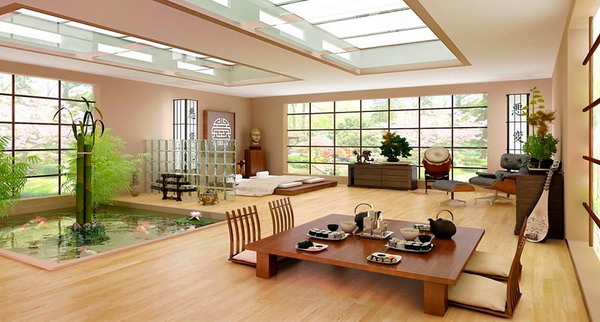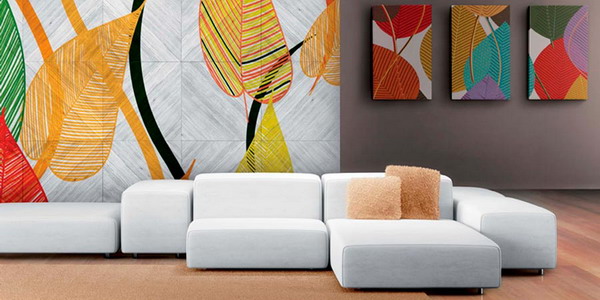Japanese Style Interior Design Trends
 The ultra-modern design of the space of large cities with their bright colors, loud sounds causes stress and fatigue in a person. Therefore, more and more people prefer discreet, serene interiors with a relaxing atmosphere. In this case, the Japanese style interior is an excellent choice. It was formed in the XVI-XVII centuries, but the traditional elements are surprisingly consonant with modernity.
The ultra-modern design of the space of large cities with their bright colors, loud sounds causes stress and fatigue in a person. Therefore, more and more people prefer discreet, serene interiors with a relaxing atmosphere. In this case, the Japanese style interior is an excellent choice. It was formed in the XVI-XVII centuries, but the traditional elements are surprisingly consonant with modernity.
The Japanese style is based on minimalism, a person’s desire for harmony with nature and the world around him. This design option is especially relevant for compact studio apartments, bedrooms, living rooms, summer cafes. Using simple basic elements creates a spacious feel. Choosing this style, it is important to feel the philosophy of the Japanese: the bustle of the world around you should not invade your thoughts, living space, only order in actions and mind is important.
To achieve inner harmony, there is no need to use bright decor, a large amount of furniture, too expensive things. It is important to see beauty in simplicity, in everyday surroundings. The Japanese style is suitable for people who seek peace, value order, subtly feel high aesthetics.
The History Of The Style
The restrained character of the traditional Japanese style was formed under the influence of a number of factors:
- high probability of earthquakes;
- climate features;
- overpopulation of islands (which means minimal living space);
- almost complete absence of natural resources;
- the nuances of life philosophy, national customs.
The characteristic interior style originated in the 16th-17th centuries, when the number of wealthy families began to grow in the country. But the national philosophy guided people towards the achievement of other values: the benefits of the modern world mean nothing in comparison with the beauty, primordiality of the world. That is why the Japanese did not begin to decorate their houses according to the Western model, abandoning bulky refined furniture, carpets, sculptures, and stucco moldings.
Frequent earthquakes have shaped the tradition of building fairly light modular homes. In the event of a collapse in such a building, the probability of surviving is higher, and in the future you can assemble the house as a constructor. Ancient residential buildings were often erected on a collapsible foundation – if necessary, you could simply move it to a new location. In a traditional Japanese home, there are no internal walls, which makes the space more open and free.
The free layout made it possible to compensate for the small area of the dwelling. Families tried to save free space, using the minimum amount of furniture, textiles, decorative elements in the interior. Minimalism is closest to Japanese style, but the latter has its own charm. The absence of main walls did not prevent to provide a pronounced zoning of the home space. This was achieved with screens, shoji (sliding doors), multi-level floors and ceilings, accent or diffused lighting.
The modern version of the Japanese interior style is slightly different from the traditional version of the 17th century. Interaction with Western culture, technological progress, advances in construction and design have enriched and transformed visual design trends. Together with natural materials, steel structures, concrete, artificial surfaces imitating stone or wood are actively used today. At the same time, refined laconicism, the desire for unity with nature, have been preserved.
Basic Principles Of Japanese Style
- The main role is assigned to nature. If the Japanese style was chosen for the design of a country house, then it is necessary to refine the space around it. The dwelling plays a secondary role, becoming an organic addition and continuation of the garden. Wide windows should offer a picturesque view of a decorative pond, a bench under a curved tree, and a blooming lawn. In the case of an apartment, it is enough to decorate the interior with an aquarium, live bamboo, bonsai, and various greenery.
- Light palette prevails. The beauty of natural materials will sparkle in a new way thanks to the use of warm calm shades: sand, beige, white, cream. Often black is used for decoration in the Japanese style, but it plays a supporting role, it is used as a background on which light details look even more expressive.
- Natural materials. The leading place in the interior is occupied by natural surfaces or high-quality imitation of stone, wood, straw, bamboo. Natural shades and texture are important.
- Squat furniture. Interior items seem to tend downward: they lack high legs and headboards. Preference is given to smooth monophonic surfaces, strict geometry.
- Laconic composition. The interior should be devoid of catchy details, the decor is reduced to a functional minimum.
- Less walls. To mark the boundaries of the rooms, it is enough to use sliding partitions in the form of a wooden frame, complemented by inserts of rice paper. This will free up even more space, if necessary, it is easy to combine rooms.
Japanese Interior Colors
For Japanese-style interiors, it is necessary to use pure colors without complex midtones. You should also abandon sharp contrasting combinations. This reflects the traditional desire for order, the desire to exclude even visual chaos. The basic colors of the Japanese interior are red, white and black. They can be used individually or sparingly all at once.
It is enough to use one pure color in combination with surfaces made of natural materials with an expressive texture. Rough, uneven stone, wood with knots and year rings, bamboo mats will do. To revive and emphasize the main areas, you can use several red details (symbolizing masculinity, strength). To create a sense of harmony and serenity, it is appropriate to use dark shades. This option is less popular than light solutions, but acceptable. The main thing is to maintain the rigor of geometry, order and conciseness.
Use Of Eco-Materials
To reflect the flavor of Japanese dwelling, you need to choose materials that were available to the inhabitants of the islands in the past. They were taken from the local nature, since most of the indigenous people did not have access to imported goods. Traditional materials include:
- silk;
- stone tiles;
- vine, matting;
- cedar, maple, kiri or sugi;
- bamboo, reed.
Even in a modern Japanese home, the use of linoleum, plastic, vinyl is very limited. It is permissible to use environmentally friendly materials, whose surface imitates natural raw materials. So, instead of wooden boards, you can use a high-quality laminate with a similar texture, instead of silk – cheaper, but similar in properties textiles.
Furniture Selection
The Japanese style is suitable for a person striving for contemplation, who prefers to relax at home from the hustle and bustle of everyday life. Therefore, for furnishing, they use the minimum of necessary furniture in a simple design. A distinctive feature remains short legs and the general “earthiness” of objects. Traditionally they select:
- straw or matting mats;
- wide low table for lunch and tea drinking, surrounded by pillows;
- tatami or mattress instead of a regular bed;
- hearth and closed kitchen cabinets;
- bath ofuro, bowl-shaped sinks for the bathroom.
Even furniture made of expensive wood species has always kept the simplicity of design, its cost was not conspicuous. Modern home furnishings have retained this feature. For a home in the national style, you can choose modern furniture from the Japanese collection or purchase antiques.
The Use Of Partitions In The Interior
Shoji are traditional partitions that give Japanese dwellings a distinctive flavor and a practical function. The panels, made of bamboo and rice paper, were considered a more practical analogue of walls, as they could withstand an earthquake. It was easy to replace them if necessary. Sliding doors allow you to change the layout with one hand movement.
Today manufacturers offer two main options for shoji: sliding doors with a traditional pattern and decorative panels for decorating walls and ceilings. Portable screens will also help to give the room coziness. They can be plain or with a minimalistic pattern (landscapes, flowers, trees, ocean).
Window And Wall Decoration
In a traditional Japanese house, the windows were large enough to include awnings that diverted rainwater and scattered direct sunlight. Thanks to this, the rooms were illuminated by soft light during the day, and in the morning and evening hours, twilight reigned in them. Today, textile or paper canvases can be used to create this effect. Such screen curtains move horizontally, there are no ruffles or draperies in the design. It is permissible to use minimalistic Roman or roller blinds.
The walls can be simply plastered, sheathed with wood panels, pasted over with plain pastel wallpaper. Solutions that combine several materials at once look spectacular. The surface can be left empty or decorated with engravings depicting nature, calligraphic inscriptions. In any case, the decor should be minimalistic.
Floor And Ceiling Decoration
Durable wood, pebbles, natural stone tiles are used as the basis for the floor. On top for greater comfort, you can lay tatami, lint-free carpet made of coarse fiber, mats made of reeds, vines. In a modern apartment you can use:
- matte ceramic tiles;
- laminate, light-colored parquet board;
- Self-leveling floors.
Open-plan ceilings are made multi-level, each zone is finished in different ways. It is important to maintain consistency with the general style and a few key principles:
- clear geometric shapes;
- the color can match the shade of the walls;
- for decoration use matte paint, wallpaper, fabric, finished panels.
Choosing Fabrics For The Japanese Interior And Placing Accents
Preference should be given to natural textiles in soothing shades. Cotton, linen, silk, fabrics with a mixed composition are suitable. Textile elements depicting scenes from the life of samurai, the landscapes of Mount Fuji, animals, hieroglyphs will effectively complement the furnishings.
When choosing details for placing accents, you need to take care of maintaining the overall balance of the interior. You can use elements of a more contrasting color or with a different pattern. The accents are usually:
- bonsai plants;
- vases, decorative porcelain;
- engravings, paintings;
- items for the tea ceremony;
- screens;
- paper lanterns;
- figurines of Buddha.
The Japanese style remains one of the most popular among contemporary designers around the world. To bring exotic flavor to the atmosphere of a city apartment, it is enough to follow only the basic tips on decor.





